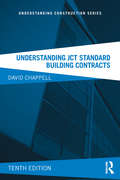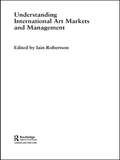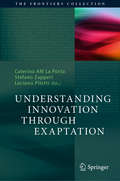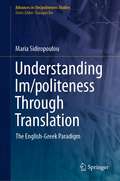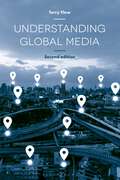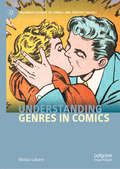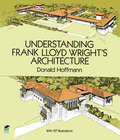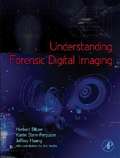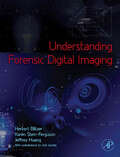- Table View
- List View
Understanding Machinima: Essays on Filmmaking in Virtual Worlds
by Jenna NgIn this groundbreaking collection, Dr. Jenna Ng brings together academics and award-winning artists and machinima makers to explore the fascinating combination of cinema, animation and games in machinima (the use of computer game engines to produce animated films in cost- and time-efficient ways). Book-ended by a preface by Henry Lowood (curator for history of science and technology collections at Stanford University) and an interview with Isabelle Arvers (machinima artist, trainer, critic, and curator), the collection features wide-ranging discussions addressing machinima not only from diverse theoretical perspectives, but also in its many dimensions as game art, First Nations media art, documentary, and pedagogical tool. Making use of interactive multimedia to enhance the text, each chapter features a QR code which leads to a mobile website cross-referencing with its print text, integrating digital and print content while also taking into account the portability of digital devices in resonance with machinima's mobile digital forms. Exploring the many dimensions of machinima production and reception, Understanding Machinima extends machinima's critical scholarship and debate, underscoring the exciting potential of this emerging media form.
Understanding Love: Philosophy, Film, and Fiction
by Susan Wolf Christopher GrauThis collection of original essays, written by scholars from disciplines across the humanities, addresses a wide range of questions about love through a focus on individual films, novels, plays, and works of philosophy. The essays touch on many varieties of love, including friendship, romantic love, parental love, and even the love of an author for her characters. How do social forces shape the types of love that can flourish and sustain themselves? What is the relationship between love and passion? Is love between human and nonhuman animals possible? What is the role of projection in love? These questions and more are explored through an investigation of works by authors ranging from Henrik Ibsen to Ian McEwan, from Rousseau to the Coen Brothers.
Understanding Language Classroom Contexts: The Starting Point for Change
by Martin Wedell Angi MalderezArguably the whole point of education is to effect change in what people know and are able to do. Globalization has contributed to a common perception worldwide of the need to introduce changes to the teaching and learning of languages. The success of many attempts to do so has been limited by insufficient consideration of implementation contexts. Understanding Language Classroom Contexts explores and illustrates how what happens in any (language) classroom is influenced by (and can be an influence on) the contexts in which it is situated. A clear understanding of these influences is thus the starting point for planning effective change. The book considers many visible and invisible features of the multiple layers of any context, and provides a framework for understanding the types of factors that may influence whether changes (planned by a teacher or externally initiated) are likely to be successful. The book will help teachers (and educational managers or change planners outside the classroom) to understand why their classrooms are as they are and so to make informed decisions about what can or cannot (or not easily) be changed, and suggests how any changes might be appropriately managed.
Understanding Language Classroom Contexts: The Starting Point for Change
by Martin Wedell Angi MalderezArguably the whole point of education is to effect change in what people know and are able to do. Globalization has contributed to a common perception worldwide of the need to introduce changes to the teaching and learning of languages. The success of many attempts to do so has been limited by insufficient consideration of implementation contexts. Understanding Language Classroom Contexts explores and illustrates how what happens in any (language) classroom is influenced by (and can be an influence on) the contexts in which it is situated. A clear understanding of these influences is thus the starting point for planning effective change. The book considers many visible and invisible features of the multiple layers of any context, and provides a framework for understanding the types of factors that may influence whether changes (planned by a teacher or externally initiated) are likely to be successful. The book will help teachers (and educational managers or change planners outside the classroom) to understand why their classrooms are as they are and so to make informed decisions about what can or cannot (or not easily) be changed, and suggests how any changes might be appropriately managed.
Understanding Korean Film: A Cross-Cultural Perspective (Routledge Studies in East Asian Translation)
by Jieun Kiaer Loli KimFilm viewing presents a unique situation in which the film viewer is unwittingly placed in the role of a multimodal translator, finding themselves entirely responsible for interpreting multifaceted meanings at the mercy of their own semiotic repertoire. Yet, researchers have made little attempt, as they have for literary texts, to explain the gap in translation when it comes to multimodality. It is no wonder then that, in an era of informed consumerism, film viewers have been trying to develop their own toolboxes for the tasks that they are faced with when viewing foreign language films by sharing information online. This is particularly the case with South Korean film, which has drawn the interest of foreign viewers who want to understand these untranslatable meanings and even go as far as learning the Korean language to do so. Understanding Korean Film: A Cross-Cultural Perspective breaks this long-awaited ground by explaining the meaning potential of a selection of common Korean verbal and non-verbal expressions in a range of contexts in South Korean film that are often untranslatable for English-speaking Western viewers. Through the selection of expressions provided in the text, readers become familiar with a system that can be extended more generally to understanding expressions in South Korean films. Formal analyses are presented in the form of in-depth discursive deconstructions of verbal and non-verbal expressions within the context of South Korea’s Confucian traditions. Our case studies thus illustrate, in a more systematic way, how various meaning potentials can be inferred in particular narrative contexts.
Understanding Korean Film: A Cross-Cultural Perspective (Routledge Studies in East Asian Translation)
by Jieun Kiaer Loli KimFilm viewing presents a unique situation in which the film viewer is unwittingly placed in the role of a multimodal translator, finding themselves entirely responsible for interpreting multifaceted meanings at the mercy of their own semiotic repertoire. Yet, researchers have made little attempt, as they have for literary texts, to explain the gap in translation when it comes to multimodality. It is no wonder then that, in an era of informed consumerism, film viewers have been trying to develop their own toolboxes for the tasks that they are faced with when viewing foreign language films by sharing information online. This is particularly the case with South Korean film, which has drawn the interest of foreign viewers who want to understand these untranslatable meanings and even go as far as learning the Korean language to do so. Understanding Korean Film: A Cross-Cultural Perspective breaks this long-awaited ground by explaining the meaning potential of a selection of common Korean verbal and non-verbal expressions in a range of contexts in South Korean film that are often untranslatable for English-speaking Western viewers. Through the selection of expressions provided in the text, readers become familiar with a system that can be extended more generally to understanding expressions in South Korean films. Formal analyses are presented in the form of in-depth discursive deconstructions of verbal and non-verbal expressions within the context of South Korea’s Confucian traditions. Our case studies thus illustrate, in a more systematic way, how various meaning potentials can be inferred in particular narrative contexts.
Understanding JCT Standard Building Contracts (Understanding Construction)
by David ChappellThis tenth edition of David Chappell’s bestselling guide has been revised to take into account changes made in 2016 to payment provisions, loss and/or expense, insurance and many other smaller but significant changes, and includes a section on performance bonds and guarantees. This remains the most concise guide available to the most commonly used JCT building contracts: Standard Building Contract with quantities, 2016 (SBC16), Intermediate Building Contract 2016 (IC16), Intermediate Building Contract with contractor’s design 2016 (ICD16), Minor Works Building Contract 2016 (MW16), Minor Works Building Contract with contractor’s design 2016 (MWD16) and Design and Build Contract 2016 (DB16). Chappell avoids legal jargon and writes with authority and precision. Architects, quantity surveyors, contractors and students of these professions will find this a practical and affordable reference tool arranged by topic.
Understanding JCT Standard Building Contracts (Understanding Construction)
by David ChappellThis tenth edition of David Chappell’s bestselling guide has been revised to take into account changes made in 2016 to payment provisions, loss and/or expense, insurance and many other smaller but significant changes, and includes a section on performance bonds and guarantees. This remains the most concise guide available to the most commonly used JCT building contracts: Standard Building Contract with quantities, 2016 (SBC16), Intermediate Building Contract 2016 (IC16), Intermediate Building Contract with contractor’s design 2016 (ICD16), Minor Works Building Contract 2016 (MW16), Minor Works Building Contract with contractor’s design 2016 (MWD16) and Design and Build Contract 2016 (DB16). Chappell avoids legal jargon and writes with authority and precision. Architects, quantity surveyors, contractors and students of these professions will find this a practical and affordable reference tool arranged by topic.
Understanding Islamic Architecture
by Attilo Petruccioli Khalil K. PiraniThe ongoing debate among practitioners and in academia about the meaning and understanding of Islamic architecture will be energized by this book. It contains essays by architects and academics from various parts of the world which clarify how the carious disciplines of the design profession can be employed to build in the spirit of Islam. Divided into three sections the book covers: *meaning from Faith, which draws meaning from the Islamic faith in order to propose a built environment that is universally beneficial*analysis of History, which examines historical buildings and planning concepts, and suggest how to apply lessons learned to contemporary practice*contemporary Trends, which discusses current trends in architecture, education and socio-economic aspects of various Muslim countries. Illustrated throughout, this book will appeal to students and scholars, practising architects and planners alike.
Understanding Islamic Architecture
by Attilo Petruccioli Khalil K. PiraniThe ongoing debate among practitioners and in academia about the meaning and understanding of Islamic architecture will be energized by this book. It contains essays by architects and academics from various parts of the world which clarify how the carious disciplines of the design profession can be employed to build in the spirit of Islam. Divided into three sections the book covers: *meaning from Faith, which draws meaning from the Islamic faith in order to propose a built environment that is universally beneficial*analysis of History, which examines historical buildings and planning concepts, and suggest how to apply lessons learned to contemporary practice*contemporary Trends, which discusses current trends in architecture, education and socio-economic aspects of various Muslim countries. Illustrated throughout, this book will appeal to students and scholars, practising architects and planners alike.
Understanding International Art Markets and Management
by Iain RobertsonThis groundbreaking text brings together experts in the field of visual art markets to answer some fundamental questions: Is art a good investment? Why is the art market dominated by America and Western Europe? Where are the key emerging markets and what are the next good buys in art? Providing readers with an understanding of the challenges facing art market 'makers' (dealers, auctioneers, collectors and artists) and the decision-making process experienced by market 'players' and investors, this exciting text merges the key theories with examples of practice in a highly accessible style. Written by an international array of experts from the US, the UK and China, this book is essential reading for all those studying or interested in art markets and management.
Understanding International Art Markets and Management
by Iain RobertsonThis groundbreaking text brings together experts in the field of visual art markets to answer some fundamental questions: Is art a good investment? Why is the art market dominated by America and Western Europe? Where are the key emerging markets and what are the next good buys in art? Providing readers with an understanding of the challenges facing art market 'makers' (dealers, auctioneers, collectors and artists) and the decision-making process experienced by market 'players' and investors, this exciting text merges the key theories with examples of practice in a highly accessible style. Written by an international array of experts from the US, the UK and China, this book is essential reading for all those studying or interested in art markets and management.
Understanding Innovation Through Exaptation (The Frontiers Collection)
by Caterina AM La Porta Stefano Zapperi Luciano PilottiThis book explores the role of exaptation in diverse areas of life, with examples ranging from biology to economics, social sciences and architecture. The concept of exaptation, introduced in evolutionary biology by Gould and Vrba in 1982, describes the possibility that already existing traits can be exploited for new purposes throughout the evolutionary process. Edited by three active scholars in the fields of biology, physics and economics, the book presents an interdisciplinary collection of expert viewpoints illustrating the importance of exaptation for interpreting current reality in various fields of investigation. Using the lenses of exaptation, the contributing authors show how to view the overall macroscopic landscape as comprising many disciplines, all working in unity within a single complex system. This book is the first to discuss exaptation in both hard and soft disciplines and highlights the role of this concept in understanding the birth of innovation by identifying key elements and ideas. It also offers a comprehensive guide to the emerging interdisciplinary field of exaptation, provides didactic explanations of the basic concepts, and avoids excessive jargon and heavy formalism. Its target audience includes graduate students in physics, biology, mathematics, economics, psychology and architecture; it will also appeal to established researchers in the humanities who wish to explore or enter this new science-driven interdisciplinary field.
Understanding Im/politeness Through Translation: The English-Greek Paradigm (Advances in (Im)politeness Studies)
by Maria SidiropoulouThis book offers a unique window to the study of im/politeness by looking at a translation perspective, which offers a different set of data and allows further understanding of the phenomenon. In the arena of real-life translation practice, the workings of im/politeness are renegotiated in a different cultural context and thus pragmatically oriented cross-cultural differences become more concrete and tangible. The book focuses on the language pair English and Greek, a strategic choice with Greek as a less widely spoken language and English as a global language. The two languages also differ in their politeness orientation in certain genres, which allows for a fruitful comparison. The volume focuses on press translation first, then translation of academic texts and translation for the stage, and finally audiovisual translation (mainly subtitles). These genres highlight a public, an interactional, and a multimodal dimension in the workings of im/politeness.
Understanding Illustration (PDF)
by Derek Brazell Jo DaviesUnderstanding Illustration asserts the continued power of illustration as a vehicle for meaning and message by offering an in-depth examination of a selection of great images by a broad range of artists. While many illustration books have minimal information surrounding their pictures, Understanding Illustration in contrast focuses in on a selection of work by 37 artists with an analytical and in-depth approach, showing how illustrators communicate through their images in order to narrate a story or stimulate thought. This stunning book offers both glorious images as well as informative text, including information on the artist but more importantly an explanation of the ideas behind the work. Looking at a broad range of illustration, from journalistic reportage to children's books, it offers an insight into how an artist might tackle a brief, or build up layers of information within their image in order to get a message across. A fantastic book for students and professional illustrators, or indeed anyone interested in the thinking behind contemporary illustration.
Understanding Human Activities Through 3D Sensors: Second International Workshop, UHA3DS 2016, Held in Conjunction with the 23rd International Conference on Pattern Recognition, ICPR 2016, Cancun, Mexico, December 4, 2016, Revised Selected Papers (Lecture Notes in Computer Science #10188)
by Hazem Wannous Pietro Pala Mohamed Daoudi Francisco Flórez-RevueltaThis book constitutes the revised selected papers of the Second International Workshop on Understanding Human Activities through 3D Sensors, UHA3DS 2016, that was held in conjunction with the 23rd International Conference on Pattern Recognition, ICPR 2016, held in Cancun, Mexico, in December 2016. The 9 revised full papers were carefully reviewed and selected from 12 submissions. The papers are organized in topical sections on Behavior Analysis, Human Motion Recognition, and Application Datasets.
Understanding Hieroglyphs: A Quick and Simple Guide
by Hilary WilsonFor more than 1500 years the hieroglyphs of ancient Egypt defied interpretation but were thought to conceal ancient wisdom and religious secrets. When at last they were deciphered, the hieroglyphs provided a surprisingly vivid picture of all areas of life, from religious myth and ritual to the everyday concerns of ordinary people. In Understanding Hieroglyphs, Hilary Wilson provides translations of hundreds of the most commonly used hieroglyphs, with examples from monuments, documents and museum exhibits. At the same time, she explains the significance of the terms used, so that the reader gains a fuller understanding of what the original scribe was trying to convey. Fully illustrated throughout with line drawings, tables and maps, this extraordinary book will enthral anyone who wants to have the satisfaction of actually being able to read some of the hieroglyphs that adorn the hundreds of Egyptian monuments and artefacts in Egypt and beyond – unlocking the secrets of this ancient civilization.
Understanding Global Media
by Terry FlewThis key textbook provides a comprehensive and up-to-date account of developments in international communication worldwide. Taking a comparative approach to the major theories of global media, Terry Flew looks at the rise of global media production networks and the emergence of 'media cities', multiculturalism, and the question of a global media culture. This engaging book raises the question of whether we are now in a 'post-global' age, and discusses whether there is a stable global communications order, or instead a stage of increased competition among digital and traditional media, and between the US and emergent powers such as China.Drawing on a wide range of perspectives, and written by a renowned author, this is an essential introduction for undergraduate and postgraduate students of media studies, communication studies and cultural studies, and anyone interested in the study of media and globalization.
Understanding Global Media
by Terry FlewThis key textbook provides a comprehensive and up-to-date account of developments in international communication worldwide. Taking a comparative approach to the major theories of global media, Terry Flew looks at the rise of global media production networks and the emergence of 'media cities', multiculturalism, and the question of a global media culture. This engaging book raises the question of whether we are now in a 'post-global' age, and discusses whether there is a stable global communications order, or instead a stage of increased competition among digital and traditional media, and between the US and emergent powers such as China.Drawing on a wide range of perspectives, and written by a renowned author, this is an essential introduction for undergraduate and postgraduate students of media studies, communication studies and cultural studies, and anyone interested in the study of media and globalization.
Understanding German Real Estate Markets (Management for Professionals)
by Tobias Just and Wolfgang MaennigReal estate is the biggest real asset class in an economy, and Germany is the biggest economy in Europe. This implies opportunities as well as specific risks for investors and policy makers. As the German real estate markets have by and large been spared severe disruptions in the course of the economic crisis, many questions arise for investors and academics alike. What are the key institutional characteristics of the German real estate markets that make it different? What are the short and long-term drivers of demand and supply? Which regional and functional market segments are most likely to outperform in the next few years? What are the most important pitfalls for investors in Germany? This book gives answers to these and many more questions. The editors have invited a broad range of extensively knowledgeable practitioners and academics from across the relevant real estate spectrum, i.e. economic, legal, tax, planning and financing issues, to express their views. There is no better English publication that gives such a profound and simultaneously entertaining overview of Germany’s real estate markets.
Understanding Geometric Algebra: Hamilton, Grassmann, and Clifford for Computer Vision and Graphics
by Kenichi KanataniUnderstanding Geometric Algebra: Hamilton, Grassmann, and Clifford for Computer Vision and Graphics introduces geometric algebra with an emphasis on the background mathematics of Hamilton, Grassmann, and Clifford. It shows how to describe and compute geometry for 3D modeling applications in computer graphics and computer vision.Unlike similar texts
Understanding Genres in Comics (Palgrave Studies in Comics and Graphic Novels)
by Nicolas LabarreThis book offers a theoretical framework and numerous cases studies – from early comic books to contemporary graphic novels – to understand the uses of genres in comics. It begins with the assumption that genre is both frequently used and undertheorized in the medium. Drawing from existing genre theories, particularly in film studies, the book pays close attention to the cultural, commercial, and technological specificities of comics in order to ground its account of the dynamics of genre in the medium. While chronicling historical developments, including the way public discourses shaped the horror genre in comics in the 1950s and the genre-defining function of crossovers, the book also examines contemporary practices, such as the use of hashtags and their relations to genres in self-published online comics.
Understanding Frank Lloyd Wright's Architecture
by Donald Hoffmann"May be the best book on Wright ever written, with the exception of the master's own incomparable autobiography." — New York Times Book ReviewDespite the vast literature about Frank Lloyd Wright, noted Wright scholar Donald Hoffmann contends that observations about Wright commonly fail to reach any understanding of his art and few commentaries deal with the principles of his architecture. What inspired his work? How did his architecture mature? What are the dynamics of its characteristic expression? Why will the formative principles always be valid?The answers to these and other questions about Wright's architectural philosophy, ideals and methods can be found in this superb treatment, enhanced with 127 photos, plans, and illustrations of a host of Wright masterworks. Among these are the Robie house, the Winslow house, Fallingwater, Hollyhock House, the Larkin Building, Unity Temple, Taliesin, the Guggenheim Museum, the Johnson Wax Building, and many more.Expertly analyzing Wright's approach to siting, furnishing, landscaping, and other details, Mr. Hoffmann has written an insightful guide to the concepts that gave Wright's architecture "not only its extraordinary vigor of structure and form, expression and meaning, but its surprising continuity." The book will be essential reading for all Wright fans and anyone interested in the evolution of modern architecture.
Understanding Forensic Digital Imaging (PDF)
by Herbert L. Blitzer Karen Stein-Ferguson Jeffrey HuangUnderstanding Forensic Digital Imaging offers the principles of forensic digital imaging and photography in a manner that is straightforward and easy to digest for the professional and student. It provides information on how to photograph any setting that may have forensic value, details how to follow practices that are acceptable in court, and recommends what variety of hardware and software are most valuable to a practitioner. In addition to chapters on basic topics such as light and lenses, resolution, and file formats, the book contains forensic-science-specific information on SWGIT and the use of photography in investigations and in court. Of particular note is Chapter 17, Establishing Quality Requirements, which offers information on how to create a good digital image, and is more comprehensive than any other source currently available. Covers topics that are of vital importance to the practicing professional Serves as an up-to-date reference in the rapidly evolving world of digital imaging Uses clear and concise language so that any reader can understand the technology and science behind digital imaging
Understanding Forensic Digital Imaging
by Herbert L. Blitzer Karen Stein-Ferguson Jeffrey HuangUnderstanding Forensic Digital Imaging offers the principles of forensic digital imaging and photography in a manner that is straightforward and easy to digest for the professional and student. It provides information on how to photograph any setting that may have forensic value, details how to follow practices that are acceptable in court, and recommends what variety of hardware and software are most valuable to a practitioner. In addition to chapters on basic topics such as light and lenses, resolution, and file formats, the book contains forensic-science-specific information on SWGIT and the use of photography in investigations and in court. Of particular note is Chapter 17, Establishing Quality Requirements, which offers information on how to create a good digital image, and is more comprehensive than any other source currently available.Covers topics that are of vital importance to the practicing professionalServes as an up-to-date reference in the rapidly evolving world of digital imagingUses clear and concise language so that any reader can understand the technology and science behind digital imaging




